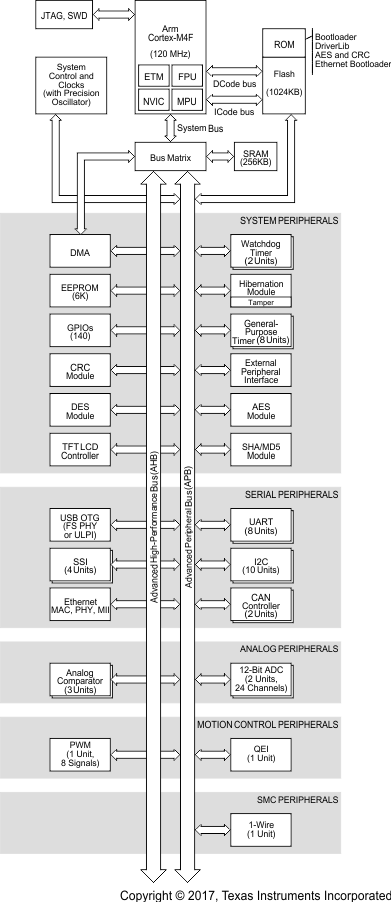-
MSP432E411Y SimpleLink™ 以太网微控制器
- 1器件概述
- 2Revision History
- 3Device Characteristics
- 4Terminal Configuration and Functions
-
5Specifications
- 5.1 Absolute Maximum Ratings
- 5.2 ESD Ratings
- 5.3 Recommended Operating Conditions
- 5.4 Recommended DC Operating Conditions
- 5.5 Recommended GPIO Operating Characteristics
- 5.6 Recommended Fast GPIO Pad Operating Conditions
- 5.7 Recommended Slow GPIO Pad Operating Conditions
- 5.8 GPIO Current Restrictions
- 5.9 I/O Reliability
- 5.10 Current Consumption
- 5.11 Peripheral Current Consumption
- 5.12 LDO Regulator Characteristics
- 5.13 Power Dissipation
- 5.14 Thermal Resistance Characteristics, 212-Pin ZAD (NFBGA) Package
- 5.15
Timing and Switching Characteristics
- 5.15.1 Load Conditions
- 5.15.2 Power Supply Sequencing
- 5.15.3 Reset Timing
- 5.15.4
Clock Specifications
- 5.15.4.1 PLL Specifications
- 5.15.4.2 PIOSC Specifications
- 5.15.4.3 Low-Frequency Oscillator Specifications
- 5.15.4.4 Hibernation Low-Frequency Oscillator Specifications
- 5.15.4.5 Main Oscillator Specifications
- 5.15.4.6 Main Oscillator Specification WIth ADC
- 5.15.4.7 System Clock Characteristics With USB Operation
- 5.15.5 Sleep Modes
- 5.15.6 Hibernation Module
- 5.15.7 Flash Memory
- 5.15.8 EEPROM
- 5.15.9 Input/Output Pin Characteristics
- 5.15.10 External Peripheral Interface (EPI)
- 5.15.11 Analog-to-Digital Converter (ADC)
- 5.15.12 Synchronous Serial Interface (SSI)
- 5.15.13 Inter-Integrated Circuit (I2C) Interface
- 5.15.14
Ethernet Controller
- 5.15.14.1 DC Characteristics
- 5.15.14.2 Clock Characteristics for Ethernet
- 5.15.14.3
AC Characteristics
- Table 5-42 Ethernet Controller Enable and Software Reset Timing
- Table 5-43 MII Serial Management Timing
- Table 5-44 100-Mbps MII Transmit Timing
- Table 5-45 100-Mbps MII Receive Timing
- Table 5-46 100Base-TX Transmit Timing
- Table 5-47 10-Mbps MII Transmit Timing
- Table 5-48 10-Mbps MII Receive Timing
- Table 5-49 10Base-T Normal Link Pulse Timing
- Table 5-50 Auto-Negotiation Fast Link Pulse (FLP) Timing
- Table 5-51 100Base-TX Signal Detect Timing
- Table 5-52 RMII Transmit Timing
- Table 5-53 RMII Receive Timing
- 5.15.15 Universal Serial Bus (USB) Controller
- 5.15.16 LCD Controller
- 5.15.17 Analog Comparator
- 5.15.18 Pulse-Width Modulator (PWM)
- 5.15.19 Emulation and Debug
-
6Detailed Description
- 6.1 Overview
- 6.2 Functional Block Diagram
- 6.3 Arm Cortex-M4F Processor Core
- 6.4 On-Chip Memory
- 6.5
Peripherals
- 6.5.1 External Peripheral Interface (EPI)
- 6.5.2 Cyclical Redundancy Check (CRC)
- 6.5.3 Advanced Encryption Standard (AES) Accelerator
- 6.5.4 Data Encryption Standard (DES) Accelerator
- 6.5.5 Secure Hash Algorithm/Message Digest Algorithm (SHA/MD5) Accelerator
- 6.5.6 Serial Communications Peripherals
- 6.5.7 System Integration
- 6.5.8 LCD Controller
- 6.5.9 Advanced Motion Control
- 6.5.10 Analog
- 6.5.11 JTAG and Arm Serial Wire Debug
- 6.5.12 Peripheral Memory Map
- 6.6 Identification
- 6.7 Boot Modes
- 7Applications, Implementation, and Layout
- 8器件和文档支持
- 9机械、封装和可订购信息
- 重要声明
DATA SHEET
MSP432E411Y SimpleLink™ 以太网微控制器
本资源的原文使用英文撰写。 为方便起见,TI 提供了译文;由于翻译过程中可能使用了自动化工具,TI 不保证译文的准确性。 为确认准确性,请务必访问 ti.com 参考最新的英文版本(控制文档)。
1 器件概述
1.1 特性
- 内核
- 120MHz ARM®Cortex®- 具有浮点运算单元 (FPU) 的 M4F 处理器内核
- 连接
- 以太网 MAC:10/100 以太网 MAC 带媒体独立接口 (MII) 和简化媒体独立接口 (RMII)
- 以太网 PHY:具有 IEEE 1588 PTP 硬件支持的 PHY
- 通用串行总线 (USB):具有 ULPI 接口选项和链路层电源管理 (LPM) 的 USB 2.0 OTG、主机或器件
- 8 个通用异步接收器/发射器 (UART),每个具有独立计时的发送器和接收器
- 4 个四通道同步串行接口 (QSSI):提供双通道、四通道和高级 SSI 支持
- 提供高速模式支持的 10 个内部集成电路 (I2C) 模块
- 2 个 CAN 2.0 A 和 B 控制器:多播共享串行总线标准
- 1 个具有双向串行通信协议的单线制模块通过一条单线提供电源和数据
- 存储器
- 具有 4 个存储体的 1024KB 闪存存储器配置支持对每个存储体提供独立代码保护
- 具有单周期访问的 256KB SRAM 以 120MHz 时钟频率提供近 2GB/s 的内存带宽
- 6KB EEPROM:每 2 个页块写入 500k、矫正、锁定保护
- 内部 ROM:搭载有 SimpleLink™SDK 软件
- 外设驱动程序库
- 引导加载程序
- 外部外设接口 (EPI):8、16 或 32 位专用并行接口访问外部器件和存储器(SDRAM、闪存或 SRAM)
- 安全性
- 高级加密标准 (AES):基于 128、192 和 256 位密钥的硬件加速数据加密和解密
- 数据加密标准 (DES):具有 168 位有效密钥长度并且支持块密码实施的硬件加速数据加密和解密
- 安全哈希算法/消息摘要算法 (SHA/MD5):支持 SHA-1、SHA-2 和 MD5 哈希计算的高级哈希引擎
- 循环冗余校验 (CRC) 硬件
- 篡改:支持四个篡改输入和可配置篡改事件响应
- 模拟
- 2 个基于 12 位 SAR 的 ADC 模块,每个模块支持高达 200 万次/秒的采样率 (2Msps)
- 3 个独立的模拟比较器控制器
- 16 个数字比较器
- 系统管理
- JTAG 和串行线调试 (SWD):一个具有集成 ARM SWD 的 JTAG 模块提供访问和控制测试设计 特性 的途径,如 I/O 引脚监督和控制、扫描测试和调试。
- 开发套件和软件(请参阅 工具和软件)
- SimpleLink™MSP-EXP432E401Y LaunchPad™开发套件
- SimpleLink MSP432E4 软件开发套件 (SDK)
- 封装信息
- 封装:212 焊球 NFBGA (ZAD)
- 扩展工作温度(环境)范围:–40°C 至 105°C
1.2 应用
- 工业以太网网关
- 工业智能网关
- 适用于楼宇自动化的区域控制器
- 工厂自动化数据收集器和网关
- 面向电网基础设施的数据集中器
- 无线转以太网网关
1.3 说明
SimpleLink MSP432E411Y ARM®Cortex®-M4F 微控制器具有顶级性能和高级集成功能。该产品系列 用于 需要强大的控制处理和连接功能且具有成本效益的应用。
MSP432E411Y 微控制器集成了大量丰富的通信 特性, 以实现全新的高度互连设计,在性能和功耗之间实现重要的实时控制。这些微控制器具有集成式通信外设以及其他高性能的模拟和数字功能,为开发从人机界面 (HMI) 到联网系统管理控制器在内的许多不同目标应用奠定了坚实的基础。
此外,MSP432E411Y 微控制器为基于 ARM 的微控制器提供了诸多优势,如广泛可用的开发工具、片上系统 (SoC) 基础架构,以及一个庞大的用户社区。另外,这些微控制器使用 ARM Thumb®兼容的 Thumb-2®指令集来减少内存要求,并以此达到降低成本的目的。当使用 SimpleLink MSP432™SDK 时,MSP432E411Y 与 SimpleLink 系列的所有成员的代码兼容,因此使用灵活,可满足各类具体需求。
MSP432E411Y 器件是 SimpleLink 微控制器 (MCU) 平台的一部分,该平台包含 Wi-Fi®、低功耗 Bluetooth®、低于 1GHz、以太网、Zigbee、线程和主机 MCU,它们均共用一个通用、简单易用的开发环境,其中包含单核软件开发套件 (SDK) 和丰富的工具集。借助一次性集成的 SimpleLink 平台,可以将产品组合中的任何器件组合添加至您的设计中,从而在设计要求变更时实现 100% 代码重用。更多详细信息,请访问 www.ti.com/simplelink。
2 Revision History
| DATE | REVISION | NOTES |
|---|---|---|
| 2017 年 10 月 | * | 初始发行版 |
